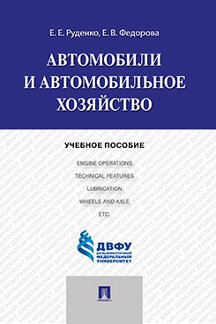|
|
ОглавлениеUNIT I. Automobile. Development of the Automobile. Automobile Industry UNIT II. Components of Automobile UNIT IV. Engine Operation. The Four-Stroke Cycle. The Two-Stroke Cycle Vocabulary. A. B. C. D. E. F. G. H. I, J, K. L. M. N. O. P, Q. R. S. T, U. V. W Для бесплатного чтения доступна только часть главы! Для чтения полной версии необходимо приобрести книгуUNIT III. EngineDiesel EngineVocabulary: capacity – мощность coal dust – угольная пыль compression of air – сжатие воздуха construction – строение, конструкция continuously operating pump – насос постоянного действия cylinder – цилиндр electric generator – электрический генератор exhaust valve – выпускной клапан explosion force – сила взрыва flywheel – маховое колесо framework – структура highly efficient – высокоэффективный ignition – зажигание, воспламенение injector – инжектор long warming-up period – долгий период нагрева low-cost fuel oil – дешевое горючее piston – поршень rapid expansion of the gas – быстрое расширение газа smooth action – гладкое действие smooth-turning effect – эффект гладкого вращения spark – искра stationary and mobile installations – стационарные и передвижные установки steam turbine – паровая турбина to be patented – быть запатентованным to convert – преобразовывать to differ from – отличаться от ... to ignite – зажигать(-ся-), воспламенять(-ся-) truck – грузовик Type of internal-combustion engine invented by the German engineer Rudolf Diesel and patented by him in 1892. Although his engine was designed to use coal dust as fuel, the diesel engine now burns low-cost fuel oil. The diesel engine does not require a large water supply or a long warming-up period and is highly efficient in converting heat energy into work. Diesels are widely used in both stationary and mobile installations where the power required is between that furnished by the gasoline engine and that of the steam turbine and where the relatively high initial cost can be written off over a long period. For example, diesels having capacities of 100 to 5,000 hp are employed on industrial and municipal electric generators and on continuously operating pumps (e.g., on oil pipelines). Moreover, they occupy relatively little space compared with steam units, since no boiler is needed – a factor of importance aboard ships. The diesel engine differs from the gasoline engine in that the ignition of fuel is caused by compression of air in its cylinders instead of by a spark: the high compression ratio allows the air in the cylinder to become hot enough to ignite the fuel. Because of the high temperatures of operation, a diesel engine must be water-cooled. The construction of the diesel engine is heavier than that of the gasoline engine; there are usually three or more cylinders (supported on a framework and bedplate) and a heavy flywheel. The cylinders are set to work alternately to give a smooth-turning effect, and the flywheel contributes further to smooth action. There are two classes of diesel engines. In the two-stroke, or two-cycle, type there is a complete cycle of operation in every two strokes of a piston. This type of engine requires a supply of compressed air for operating and for starting. In the four-stroke, or four-cycle, type the first down stroke of the piston draws in air, which is compressed on the up stroke to about 500 lb per sq in. (35 kg per sq cm). At the top of the stroke a jet of oil is sprayed in through an injector. The oil is ignited and the rapid expansion of the gas created by the explosion forces the piston down in the working, or firing, stroke. The next upstroke drives the waste gases out through the exhaust valve, and the cycle is complete. The speed and power of the diesel are controlled by varying the amount of fuel injected into the cylinder, not the amount of air admitted as in the gasoline engine. Small and medium-size ships may have several diesels producing as much as 50,000 hp. Heavy-duty land transports such as trains, trucks, buses, and tractors are often diesel-powered. Some automobiles and even some airplanes have had diesel engines. General understanding: 1. Who invented and patented diesel engine? 2. What is the deferens between the diesel engine and gasoline engine? 3. How many classes of diesel engines? 4. Where are diesel engines widely used? 5. What type of engine does require a supply of compressed air? Exercise 1. Find in the left column English equivalents of Russian words and word-combinations.
Внимание! Авторские права на книгу "Автомобили и автомобильное хозяйство. Учебное пособие" (Руденко Е.Е., Федорова Е.В.) охраняются законодательством! |
||||||||||||||||||||||||











